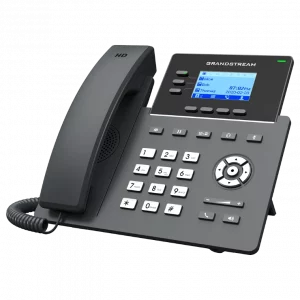
VoIP vs Traditional Phones: What’s the Difference?
Small business owners are no strangers to solving problems and getting the most for their money. However, it can be frustrating when you try to compare apples to oranges, such as comparing VoIP vs traditional phone services. Yes, they can both enable voice calls and features like call forwarding and voicemail, but that’s where the similarities end.
In this post, you’ll learn about Voice over Internet Protocol (VoIP) and the related SIP technology that makes it a complete business communications solution. You’ll find out how 82% of companies who move to cloud solutions like hosted VoIP services save money. Most importantly, you’ll be armed with the knowledge you need to make the right decision for your business. Let’s get started.
Comparing VoIP vs Traditional Phone Service
Landlines were a mainstay of business communication for many years. However, cloud-hosted VoIP and SIP trunking have come along to offer a more affordable option that does much more than enable voice calls. Cloud-hosted SIP trunking enables unified communications, making doing business from anywhere easier than ever before. Before we dive into the comparison, let’s talk more about what VoIP and SIP trunking do.
VoIP and SIP Trunking
VoIP allows the use of broadband internet service rather than copper phone lines to make and receive voice calls. Also known as IP telephony or broadband phone service, VoIP is not a new technology. It was first introduced in the mid-1990s to allow people to make phone calls through their computers, and it quickly caught on as people realized they could save money on long-distance and international calls. By 2003, just eight short years later, VoIP constituted 25% of all voice calls.
The term SIP is often used interchangeably with VoIP, but they are far from synonymous. Session Initiation Protocol (SIP) is a set of rules that enable VoIP to transmit voice calls via the internet. That means that SIP uses VoIP to move call traffic over a web connection.
Related: The Benefits of SIP Trunking for Your Business: Why You Need It Now
SIP trunks are the virtual version of traditional copper phone lines. They connect communication devices so that multiple types of digital communication can be transmitted, from voice to video, texts, instant messaging, file sharing, virtual meetings, and much more. SIP trunks act as a communication highway, and the data packets are the vehicles traveling between destinations.
Differences in VoIP vs Traditional Phone
Now that you understand a little about the technologies and protocols, we can start to compare the differences between traditional phones and VoIP. The following attributes represent some of the most significant differences between the two types of phone systems.
Mode of Transmission
VoIP converts voice to digital data that is transmitted using a broadband internet connection. You can use IP-enabled phones or your computer to make calls all over the world. Most cell phones can also use WiFi calling with apps like Skype, What’s App, Facetime, Google Meet, Snapchat, or other apps to make VoIP calls. The most reliable VoIP providers use SIP trunking to enable VoIP services, while traditional phone service, also called POTS (Plain Old Telephone Service), uses copper lines to transmit analog data.
Cost
There are many aspects to consider when it comes to the cost of a traditional business phone service. First, a landline requires service from a phone company. It may also require installing additional copper phone lines if the business is large or handles multiple concurrent calls on different extensions. In addition, it can take days or longer to wait for a service call. Costs vary depending on the work needed.
Then there is the hardware. A traditional landline Private Branch eXchange (PBX) is a common business telephone system that handles multiple, concurrent inbound and outbound calls, call management, voicemail, and call routing features. Analog phone system equipment alone can cost anywhere from $500 to $2,000 per user. That price depends upon several factors, such as the size, features, and installation needs of the system.
In contrast, VoIP can be almost instantly enabled with a low-cost plan from a reliable provider. It needs no special equipment other than your computer or optional inexpensive IP-enabled phones and a reliable broadband internet connection. With the right VoIP provider, you can also select from a wide variety of additional features.
Scalability and Flexibility
One of the most significant differences between VoIP vs traditional phones is scalability. Businesses can scale up quickly and easily with VoIP as their business needs change. Companies that are subject to seasonality and those that experience significant fluctuations in demand can even reduce their service during their down seasons.
Another useful feature of VoIP service is its flexibility. Users that are connected to a broadband network can stay in contact with their coworkers, vendors, and customers regardless of physical location. Brick-and-mortar businesses using VoIP that decide to move, simply start using their service in their new location without worrying about installation. In contrast, businesses that are using traditional landline services and decide to relocate may require a new connection, additional phone lines, or new local phone numbers if moving outside of the area.
Long-Term Outlook
Another consideration when looking at VoIP vs traditional phone systems is the long-term functionality and return on investment. As of August 2022, phone companies, in an attempt to phase out copper phone lines, are no longer required to install or service them. Even landline service providers are moving to internet-based phone services.
Related: How to Find the Best VoIP Service Provider
The demand for VoIP is not waning. The market is projected to grow significantly over the next 10 years. It was valued at $115.21 billion in 2022 and is expected to reach $472.26 billion by the end of 2033.
The Difference in VoIP vs Traditional Phone: Features, Flexibility, and Peace of Mind
The key to modernizing your communications with VoIP service is choosing a reliable, respected provider. You want to look for one that offers flexible plans, modern features, no contract, and fast setup. You need a provider that gives you control over what features you pay for. Your business needs a communications platform that works for you now with the features and flexibility to work for you in the future.
The differences between VoIP vs traditional phones are clear. SIP.US offers businesses everything they need in a single, streamlined platform that provides control, reduces costs, and supports today’s diverse workforce. When you are ready to modernize your business communications, contact us to get started.


